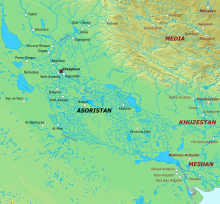Ctesiphon
After the Muslim invasion, the city fell into decay and was depopulated by the end of the eighth century, its place as a political and economic center taken by the Abbasid capital at Baghdad.
In modern Arabic, the name is usually Ṭaysafūn (طيسفون) or Qaṭaysfūn (قطيسفون) or as al-Mada'in (المدائن "The Cities", referring to Greater Ctesiphon).
Ctesiphon is first mentioned in the Book of Ezra[9] of the Old Testament as Kasfia/Casphia (a derivative of the ethnic name Cas, and a cognate of Caspian and Qazvin).
[11] Ctesiphon is located approximately at Al-Mada'in, 35 km (22 mi) southeast of the modern city of Baghdad, Iraq, along the river Tigris.
[16] The oldest inhabited places of Ctesiphon were on its eastern side, which in Islamic Arabic sources is called "the Old City" (مدينة العتيقة Madīnah al-'Atīqah), where the residence of the Sasanians, known as the White Palace (قصر الأبيض), was located.
[16][17] The western side was known as Veh-Ardashir (meaning "the good city of Ardashir" in Middle Persian), known as Mahoza by the Jews, Kokhe by the Christians, and Behrasir by the Arabs.
[21] After a campaign in 573, John of Ephesus wrote that no fewer than 292,000 persons had been deported from Dara, Apamia, and other Syrian towns to Veh-Antiokh.
[22] In 590, a member of the House of Mihran, Bahram Chobin repelled the newly ascended Sasanian ruler Khosrow II from Iraq, and conquered the region.
[23] In 627, the Byzantine Emperor Heraclius surrounded the city, the capital of the Sassanid Empire, leaving it after the Persians accepted his peace terms.
In 628, a deadly plague hit Ctesiphon, al-Mada'in and the rest of the western part of the Sasanian Empire, which even killed Khosrow's son and successor, Kavad II.
[23] In 629, Ctesiphon was briefly under the control of Mihranid usurper Shahrbaraz, but the latter was shortly assassinated by the supporters of Khosrow II's daughter Borandukht.
The Muslim military officer Sa`d ibn Abi Waqqas quickly seized Valashabad and made a peace treaty with the inhabitants of Veh-Antiok-Xusrō and Veh-Ardashir.
The terms of the treaty were that the inhabitants of Veh-Antiok-Xusrō were allowed to leave if they wanted to, but if they did not, they were forced to acknowledge Muslim authority, and also pay tribute (jizya).
[24] Still, as political and economic fortune had passed elsewhere, the city went into a rapid decline, especially after the founding of the Abbasid capital at Baghdad in the 760s, and soon became a ghost town.
The Ottoman Empire defeated troops of Britain attempting to capture Baghdad, and drove them back some 40 miles (64 km) before trapping the British force and compelling it to surrender.
In 497, the first Nestorian patriarch Mar Babai I, fixed his see at Seleucia-Ctesiphon, supervising their mission east, with the Merv metropolis as pivot.
The population also included Manicheans, a dualist church, who continued to be mentioned in Ctesiphon during Umayyad rule fixing their "patriarchate of Babylon" there.
[27] A German Oriental Society expedition led by Oscar Reuther excavated at Ctesiphon in 1928–29 mainly at Qasr bint al-Qadi on the western part of the site.
[32] In the late 1960s and early 1970s, an Italian team from the University of Turin directed by Antonio Invernizzi and Giorgio Gullini [it] worked at the part of the site on the other side of the Tigris, which they identified as Veh Ardashir.


